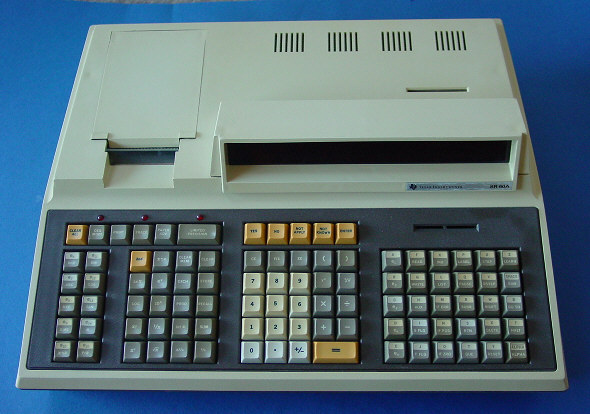
DATAMATH CALCULATOR MUSEUM
 |
DATAMATH CALCULATOR MUSEUM |
Texas Instruments SR-60
| Date of introduction: | 1976 | Display technology: | LED |
| New price: | $1695.00 | Display size: | 20 dot-matrix |
| Size: | 14.5" x 17" x 5.5" | Printer technology: | Thermal TP-30250 |
| Weight: | 16 pounds | Serial No: | |
| Batteries: | Date of manufacture: | ||
| AC-Adapter: | 120 V / 240 V | Origin of manufacture: | USA |
| Precision: | 12 | Integrated circuits: | TMC0501, TMC0526 or TMC0536, TMC0564, TMC0565, TMC0566, TMC0567, TMC0568 or TMC0570, TMC0596, 5*TMC0599, TMC0253, TMC0254 |
| Logic: | AOS - 10 Pending Operations, 9 () | ||
| Memories: | 40 | ||
| Program steps: | 480 | Courtesy of: | |
| Download manuals: | |
 Texas Instruments
introduced in 1976 with the SR-60 their first high-end programmable desktop calculator. Priced at $1695 and with a footprint of roughly 17" by 14.5" (430 mm * 370 mm) the SR-60 resembled more a computer than a programmable calculator.
Texas Instruments
introduced in 1976 with the SR-60 their first high-end programmable desktop calculator. Priced at $1695 and with a footprint of roughly 17" by 14.5" (430 mm * 370 mm) the SR-60 resembled more a computer than a programmable calculator.
Based on the SR-52 and SR-56 series of programmable calculators, the SR-60 integrated a full-sized keyboard with 95 keys, a large alphanumeric display with 20 characters, a thermal dot-matrix printer with 20 characters and a magnetic card reader for saving and loading both programs and data.
One of the main advantages of the SR-60 is the huge memory for data and program, already the base model could hold 480 program steps and 40 memory registers. Two memory expansion modules were available, one implemented with just two small daughter boards holding 5 resp. 3 TMC0599 RAM chips accessible through a bottom panel in the housing. The second memory expansion, a huge printed circuit board (PCB) with a total of 27 TMC0599 RAM chips, was mounted below the keyboard next to the Main PCB.
A fully-optioned SR-60 could hold programs with a maximum of 5760 steps and 430 memory registers.
| Configuration | Program Steps |
Memory Register |
RAM Chips |
| SR-60 base | 480 | 40 | 5 |
| Option 1 | 1920 | 100 | 13 |
| Option 2 | 5760 | 430 | 40 |
There is evidence that the SR-60 on exhibition is actually a later SR-60A:
| • Despite the SR-60 label below the display reads the serial number. • The Integrated Circuits on the different printed circuit boards (PCB) of this particular machine are dated as late as April 1978, the SR-60A was introduced early in 1977. |
Fellow collectors - if you own a Texas Instruments SR-60 calculator, please report us the serial number and date code from the back of the calculator for our Database.
SR-60 A prompting, programmable, printing calculator with an alphanumeric display that communicates with the user. $1695.00. The SR-60 card-programmable, prompting, printing calculator is designed to bridge the gap between simple desktop calculators and computers. A powerful asset to business and technical operations alike. Delivering capability found only in programmable desktop calculators costing far more. Its business capabilities ranges from solving intricate financial analyses and long-range forecasting, to simpler operations like payroll and amortization. For technology there are 46 scientific functions on the keyboard and 480 program steps for complex programming. This capacity can be expanded to 1,920 steps and 100 data memories with its optional module. Prompting: The SR-60’s unique 20-character display lets the user run alphanumeric programs which “ask” for information at successive stages of the problem. The SR-60 then waits for your response before continuing. This dialogue allows even a novice to work with complex problems immediately. Programming: Is easy and straightforward yet flexible for user with: 78 labels, 10 flags, 10 branches, 4 levels of subroutines, and 2 modes of indirect operation. Plus, complete program editing capability. And, by using the printer you can list and trace the actual program execution. Programs are easy to write and record on magnetic cards. With alphanumeric prompting, the cards can be used by assistants or secretaries. A person merely needs a minimum amount of instruction and a general concept of what’s to be solved to have answers to you in seconds. Ten prerecorded cards are included in the SR-60’s Basic Library: Power transformer and filter design. Add-on rate installment loans and compound interest. Polynomial evaluation, cubic and quadratic equations. Basic statistics. Random number generator and diagnostics. Well over 100 additional programs are available, including many on business. Printing: The SR-60’s quiet printer provides a scaled replica of what appears on the alphanumeric display on 2½-inch thermal paper. You can get a hard copy of any keyboard calculation that appears on the display, a complete program list of the contents of the data registers, whether entered from the keyboard or run from a program card. © Texas Instruments, 1976 |
If you have additions to the above article please email: joerg@datamath.org.
© Joerg Woerner, April 15, 2002. No reprints without written permission.